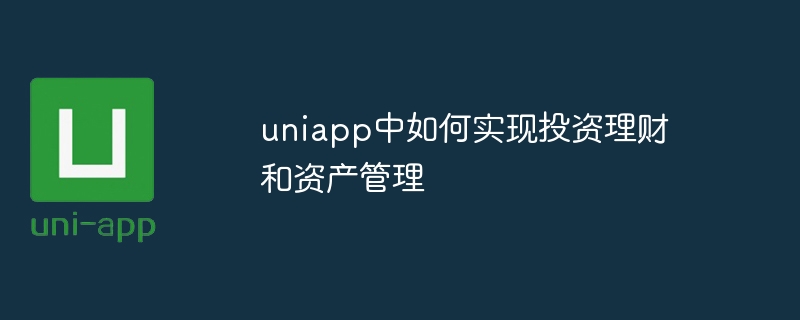

How to realize investment, financial management and asset management in uniapp
Investment, financial management and asset management are increasingly important topics in modern society. For individuals and enterprises, reasonable Investment and effective asset management can help us achieve wealth growth and risk control. This article will introduce how to use the uniapp framework to implement investment, financial management and asset management, and provide specific code examples.
First, we need to create a uniapp project and create a page named "investment" in the project. On the "investment" page, we can display information about investment products, an overview of the investment portfolio, and asset allocation. The following is a code example for a simple investment product information display page:
<template>
<view class="investment">
<view class="product-info">
<image class="product-image" :src="product.image"></image>
<text class="product-name">{{ product.name }}</text>
<text class="product-description">{{ product.description }}</text>
</view>
</view>
</template>
<script>
export default {
data() {
return {
product: {
image: "图片链接",
name: "投资产品名称",
description: "投资产品描述",
},
};
},
};
</script>
<style>
.product-image {
width: 200px;
height: 200px;
}
.product-name {
font-size: 20px;
margin-top: 20px;
}
.product-description {
margin-top: 10px;
}
</style>In the above code, we use the template syntax of uniapp to dynamically render the name, description, picture and other information of the investment product. By storing investment product information in the data object, we can easily dynamically bind data and update page display.
Next, we need to implement the asset management function. In uniapp, we can use Vuex to implement global state management, which is used to store and manage user asset information. The following is a code example of a simple asset management page:
<template>
<view class="asset-management">
<text class="total-assets">总资产: {{ totalAssets }}</text>
<ul class="asset-list">
<li v-for="asset in assetList" :key="asset.id">
<text>{{ asset.name }}: </text>
<text>{{ asset.value }}</text>
</li>
</ul>
</view>
</template>
<script>
import { mapState } from "vuex";
export default {
computed: {
...mapState(["totalAssets", "assetList"]),
},
};
</script>
<style>
.total-assets {
font-size: 20px;
margin-bottom: 20px;
}
.asset-list {
list-style-type: none;
padding: 0;
}
.asset-list li {
margin-bottom: 10px;
}
</style>In the above code, we use Vuex’s mapState method to map the total assets and asset list in the global state to the current in the computed property of the component. By defining relevant calculated properties in computed, we can easily obtain and display the user's asset information.
It should be noted that in the uniapp project, we can also call the backend interface through uni.request and other APIs to obtain investment product and asset information, and display it on the corresponding page. In actual applications, these data may need to be obtained from the backend interface and processed and displayed accordingly.
To sum up, this article introduces how to use uniapp to realize investment, financial management and asset management functions, and provides relevant code examples. By rationally utilizing the features and components of uniapp, we can easily implement investment product information display and asset management functions, thereby helping to achieve the goals of wealth growth and risk control.
The above is the detailed content of How to implement investment, financial management and asset management in uniapp. For more information, please follow other related articles on the PHP Chinese website!




